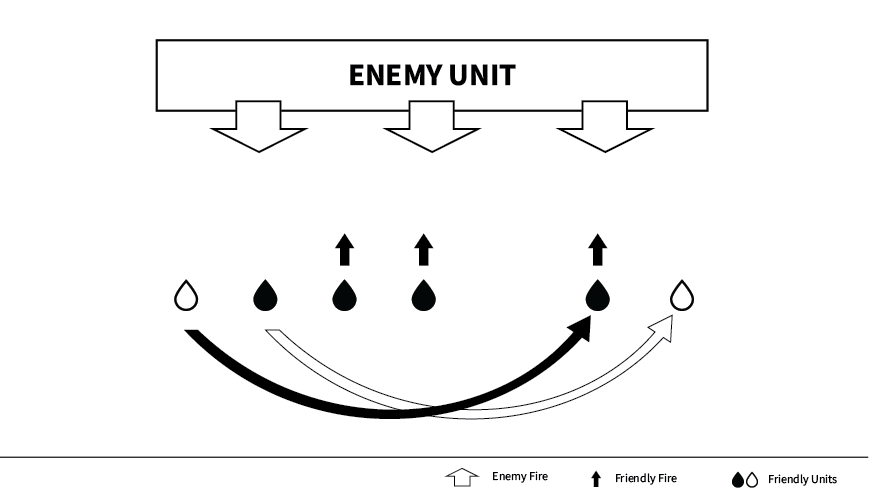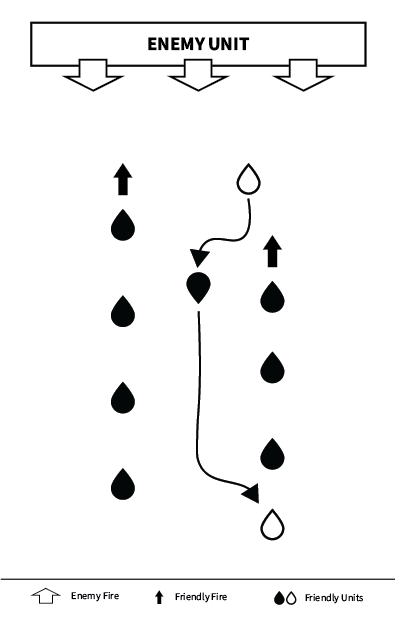Peeling
Purpose
Peeling is a tactical technique used to break contact with the enemy while maintaining continuous suppression and minimizing exposure.
It allows a section to retreat under fire in an organized, defensive manner without collapsing into chaos.
Properly executed peeling buys time, creates distance, and preserves combat power during disengagement.
Definition
- Peeling: A controlled, step-by-step movement technique where individual operators withdraw either laterally or to the rear, while maintaining suppressive fire against the enemy.
Each operator covers the withdrawal of others by alternating fire and movement, creating a moving defensive line.
Key Principles
- Continuous suppression is critical: someone must always be firing.
- Peeling movement must be orderly and announced.
- Short, controlled bounds maintain cohesion and avoid exposure.
- Communication is key to prevent overlap, confusion, or breaks in suppression.
Application
Right Peel (Lateral Peel)
- The operator furthest from the enemy peels first.
- After firing a final burst, they sprint diagonally backward past the team.
- As they pass, they announce “Peeling!” or “Move!” to the next operator.
- The process repeats until the section has broken contact or reached better cover.

Center Peel (Rearward Peel)
- Operators peel directly backward from the center, alternating suppression left and right.
- Common when needing to withdraw directly rearward under enemy pressure.
- Works well in open ground or after frontal ambushes.

Peel Movement Sequence
-
Initial Suppression
- All operators engage the enemy with suppressive fire to achieve initial suppression.
-
First Operator Peels
- The operator furthest from the threat fires a final burst, calls “Peeling!” and sprints backward (or laterally) past the rest of the team.
-
Remaining Operators Continue Suppression
- Remaining operators maintain suppression without interruption.
-
Sequential Peeling
- One by one, each operator repeats the process:
- Fire a burst.
- Announce “Peeling!” or “Moving!”.
- Move past the formation into new covered position.
- Resume suppression immediately from the new position.
- One by one, each operator repeats the process:
// UPDATE TO LAST MAN CALL 5. Last Operator
- The final operator announces “Last Man!” during their movement to signal the maneuver is complete.
📸 Suggested Image: Top-down diagram of sequential peeling with individual operators.
Communication Examples
- “Peeling right!” (for lateral movement)
- “Move!” (when passing teammates)
- “Last man!” (announced by final operator peeling back)
Common Mistakes
- Poor suppression leading to effective enemy fire during movement.
- Moving too far during bounds, causing breaks in defensive line.
- Failing to announce movement, causing overlap or confusion.
- Bunching up during retreat, making the team an easy target.
- Failing to reload during safe periods, leading to dry weapons mid-peel.
Summary
Peeling provides a disciplined method for breaking contact under fire, preserving combat power and minimizing exposure.
By maintaining constant suppression, controlling bounds, and communicating clearly, a section can disengage from superior enemy forces without falling into disarray.
Mastering both lateral (right) and rearward (center) peels ensures flexibility and survivability in dynamic combat environments.